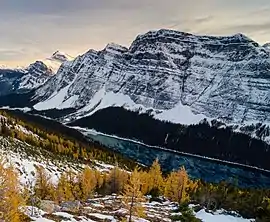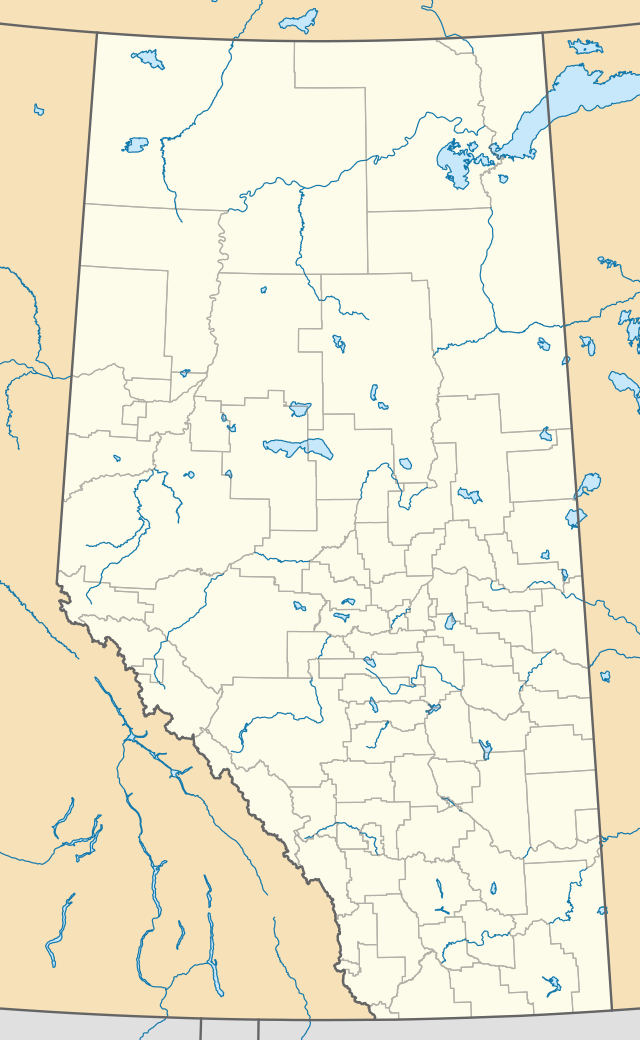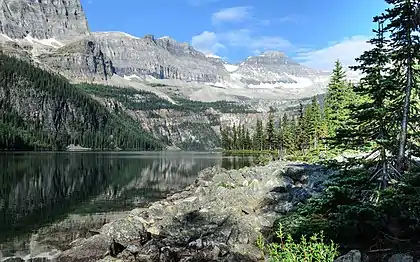Boom Mountain
Boom Mountain is located north of Vermilion Pass on the border of Alberta and British Columbia on the Continental Divide. It was named in 1908 after Boom Lake which is located right under the mountain.[1][2] When viewed by an Alpine Club of Canada expedition, a buildup of logs on the lake resembled a log boom.[4][5]
| Boom Mountain | |
|---|---|
 Boom Mountain and Boom Lake | |
| Highest point | |
| Elevation | 2,758 m (9,049 ft) [1] |
| Prominence | 442 m (1,450 ft) [2] |
| Listing | Mountains of Alberta Mountains of British Columbia |
| Coordinates | 51°15′04″N 116°04′43″W [3] |
| Geography | |
 Boom Mountain Location on Alberta-British Columbia border  Boom Mountain Boom Mountain (Canada) | |
| Location | Alberta and British Columbia, Canada |
| Parent range | Bow Range Canadian Rockies |
| Topo map | NTS 82N/08 |
| Geology | |
| Age of rock | Cambrian |
| Type of rock | Sedimentary rock |
| Climbing | |
| First ascent | 1903 Dominion Survey Party[2] |
Geology
Boom Mountain is composed of sedimentary rock laid down from the Precambrian to Jurassic periods.[6] Formed in shallow seas, this sedimentary rock was pushed east and over the top of younger rock during the Laramide orogeny.[7]
Climate
Based on the Köppen climate classification, Boom Mountain is located in a subarctic climate with cold, snowy winters, and mild summers.[8] Temperatures can drop below -20 °C with wind chill factors below -30 °C.
References
- "Boom Mountain". PeakFinder.com. Retrieved 2019-08-11.
- "Boom Mountain". Bivouac.com. Retrieved 2010-02-13.
- "Boom Mountain". BC Geographical Names. Retrieved 2013-06-29.
- Boles, Glen W.; Laurilla, Roger W.; Putnam, William L. (2006). Canadian Mountain Place Names. Vancouver: Rocky Mountain Books. p. 46. ISBN 978-1-894765-79-4.
- Place-names of Alberta. Ottawa: Geographic Board of Canada. 1928. p. 22.
- Belyea, Helen R. (1960). The Story of the Mountains in Banff National Park (PDF). parkscanadahistory.com (Report). Ottawa: Geological Survey of Canada. Archived (PDF) from the original on 2015-10-02. Retrieved 2019-09-13.
- Gadd, Ben (2008). Geology of the Rocky Mountains and Columbias.
- Peel, M. C.; Finlayson, B. L. & McMahon, T. A. (2007). "Updated world map of the Köppen−Geiger climate classification". Hydrol. Earth Syst. Sci. 11: 1633–1644. ISSN 1027-5606.
